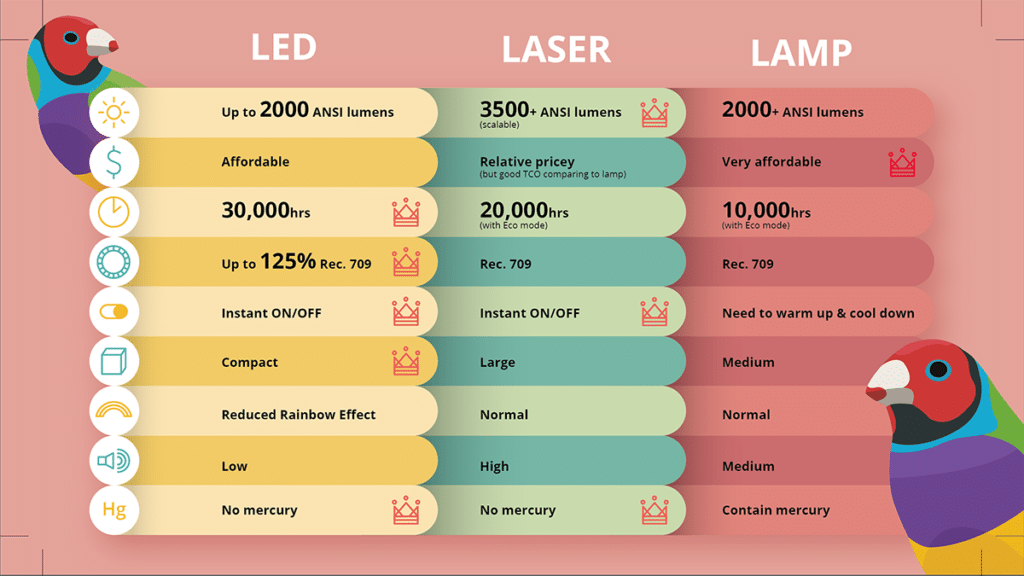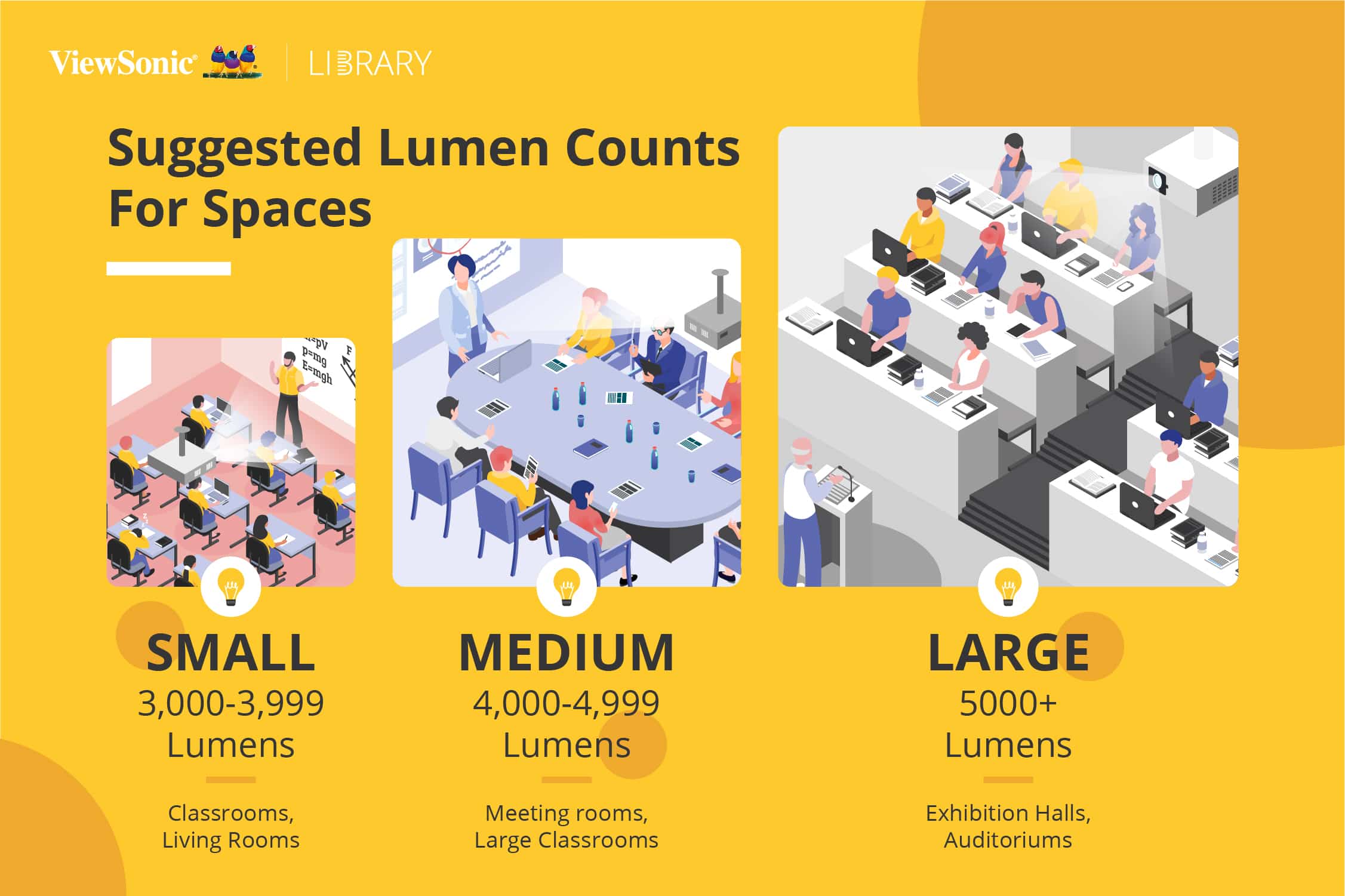When considering a lamp-free projector, it’s important to have all the facts. Comparing lamp projectors with LED projectors or laser projectors reveals each has its own strengths in terms of certain key factors like cost, image quality, and size. And each will have certain situations in which it will work better. Which one wins in the end? You’ll have to see for yourself.
Keep reading to compare projector types or click here to learn more about ViewSonic’s projectors.
There are different types of projector — LED, Laser, and Lamp-based. Are you curious as to the difference between these three variants, beyond that of lamp vs. lamp-free projectors?
If so, then we have good news. This piece serves as a complete comparison between LED projectors, laser projectors, and lamp projectors, and will help you make an informed decision as to whether to invest in a lamp or lamp-free projector.
What Are LED, Laser, and Lamp Projectors?
In order to project, projectors need a light source. Some use LEDs, some use lasers, and others use lamps. Lamp projectors are the oldest, yet cheapest, variant, with bulbs containing mercury and a relatively short lifespan. LED and Laser projectors, on the other hand, are much more modern, with consideration paid towards their more eco-friendly natures and greater lifespans.

7 Factors That Differentiate Lamp and Lamp-Free Projectors
Those brief comparisons are just that – brief. When it comes down to it, there are 7 key factors that differentiate between the three light sources that comprise lamp and lamp-free projectors – LED, lasers, and lamps. Although lamp life, cost, and brightness are the obvious data points to consider, truly discerning customers will go deeper in their quest for informed purchases. That’s where the additional factors — color quality, power-up time, the presence of the rainbow effect, and machine noise — come into play.
1. Life Span
Folks may want to buy the newest versions of products, but at the end of the day, they’d also like their currently-owned products to continue functioning. That’s why the stated life span of a projector’s light source is so important – you don’t want to invest your money in something that’ll die in short order. Luckily, in the world of projectors, even the shortest of the stated life spans for the different light sources will net you more than a year of continuous use.
Getting into the specifics, lamp, laser, and LED projectors claim to have 10K, 20K, and 30K hour life spans, respectively. This equates to, approximately, 14, 28, and 42 months of constant use respectively. For the sake of clarity, be sure to remember that these life spans indicate the length of use, not the length of ownership. If you own an LED projector for 42 months, for instance, it won’t suddenly die. Instead, if you only use your LED Projector for 6 hours a day, then the light source may stay functional for around 7000 days, or 19.2 years.
2. Cost
Money makes the world go round and it shouldn’t be spent all in one place. That’s why the cost of items, particularly in relation to one’s income, is so important. Put plainly, oftentimes, people want to get the best value for their hard-earned cash, as opposed to blowing it all at once. This concept absolutely applies to projection products, whether they are LED projectors, laser projectors, or lamp projectors. Therein, consumers should be interested in the TCO, or the total cost of ownership, of a product. This goes beyond the initial sales number and considers potential repairs and replacements that may be needed in the product’s lifespan.
When it comes to pure cash, lamp projectors are considered to be very affordable, while LED and laser projectors are deemed generally affordable and relatively expensive, respectively. However, TCO is the great equalizer in this case, as lamp projectors have the highest potential for replacements and repairs. As such, a laser projector’s high cost begins to look better, when placed against a lamp projector’s poor TCO. Something to think about, indeed.
3. Rainbow Effect
In nearly every product, glitches happen. Sometimes they can be entertaining, other times annoying, or else debilitating. Projectors are not exempt from glitches, unfortunately, and they come in the form of the rainbow effect. To understand this effect, consider how each projection type generates color. Lamp projectors and laser projectors use colored filters, or color wheels, to alter the projected light as needed. Therein, there might occasionally be moments where the color wheel is too slow, and the projected image is stained with unwanted colors. This is the rainbow effect.
Although lamp and laser projectors are stuck with the possibility of the rainbow effect, LED projectors are not. This is due to the optional presence of two color wheels, in which the rainbow effect can be filtered out before it is outwardly projected. On the other hand, since LED projectors have no need for a color wheel, as they produce colors natively, they are not at risk of experiencing the rainbow effect.
4. Brightness
What point is having a visual product if you can’t see it? You may not think about it often, but the brightness of a display is of critical importance and is a massive factor upon which final purchase decisions may rest. Think about it, if you were looking at a monitor or screen whose screens you could barely make out, would you buy it? The answer is probably a resounding, “no”.
When it comes to projectors, brightness is expressed by way of American National Standards Institute (ANSI) lumens. Therein, the higher the number, the greater the brightness. Lamp projectors tout more than 2000 ANSI lumens, while laser projectors offer more than 3500 with the option of further scaling by way of attachable modules. LED projectors, on the other hand, suffer in this regard, with a lumen count that only goes up to a maximum of 2000. However, in the case of LED projectors, this number isn’t to be taken purely at face value. In fact, LED makes up for this numerical efficiency with its higher quality image perception. This is thanks to improved color saturation and luminous efficiency, which allows LED projectors to appear to have higher image qualities than they may actually possess.
Learn more about lumens here: What Are Lumens? And How to Use Them to Choose a Projector
5. Color Performance
4K! 8K! OLED! These high-tech buzzwords are rampant in the consumer-level visual products industry. The thing is that 4K is a level of resolution and OLED is a means of light emittance – though the average consumer may think that these are one-in-the-same, all indicating high performance. This confusion carries over to color quality, which is indeed separate from resolution and light emittance and is actually determined by color gamut and saturation.
Color gamut refers to the spectrum of colors that can be identified by the human eye – a standard of which is displayed by any given visual product. Moreover, a visual display’s color saturation indicates the intensity of those colors present in the gamut. When it comes to projectors, each variant — LED, laser, and lamp — all use the same color standard, Rec. 709. However, LED projectors go one step further with the ability to offer color saturation up to 125% of the norm.
6. Power-up times
We get it, you want your device to work and you want it to work now. Instant gratification is a natural thing to want and it’s the reason behind the advent of flash memory and other ‘instant-on’ advances that have become popular in recent years. Think back to your days in school, when the projector would take a minute or two to properly boot up. That was time wasted, and thanks to those aforementioned advances, it won’t happen again.
The different projector types differ in their ability to turn on as fast as possible. On one hand, LED and laser, or the lamp-free projectors, are able to offer instant on/off capabilities. On the other hand, lamp projectors cannot. Instead, they offer exactly what you remember from school – warm-up and cool-down periods, that can take up to two minutes, before and after use.
7. Size and Sound
The most popular technological goods, in this day and age, are those that fit the mantra “the smaller the better.” Our phones are tiny, our TVs are flat, and our cars are certainly smaller than they were in decades past. Those examples are neither here nor there, however, since it’s the inside that matters. Think about it: you can have a small, well-designed product, but if its internal components aren’t up to snuff, then your money is wasted nonetheless. You know those loud machine sounds some of your products make whilst in use? Those are what you want to avoid.
This is why size and machine sound are both important factors to consider when purchasing a projector. Lamp-free projectors especially excel in this realm. LED projectors, for instance, are the top of the line in this regard, with compact designs and low-level machine sounds. Laser projectors on the other hand, because of their thermal elements laser projection systems, are both slightly larger and noisier. Lamp projectors fall in the middle in terms of size.
Learn more about how big a picture you can get out of your device here: Choosing the Right Projector Resolution for Your Needs
Deciding Between Lamp and Lamp-Free Projectors
When it comes to making a decision between a lamp and lamp-free projectors, ultimately, the final choice rests in your hands. However, we’ve done our best to provide you with the facts necessary to make the most educated choice possible. If brightness is your main focus, then laser projectors might be best for your business. If that’s the case, then we recommend the LS800HD, LS800WU, or LS830 projectors.
Lastly, if you’re interested in purchasing a projector that, although not the cheapest or brightest, excels in all other ways, including lifespan, color performance, size, mechanical noise, and rainbow effect incidence, then an LED, the lamp-free projector is most certainly for you and your home. For that, we recommend either the X10-4K projector or the M1 portable projector. To learn more about ViewSonic’s projectors for home, click here.